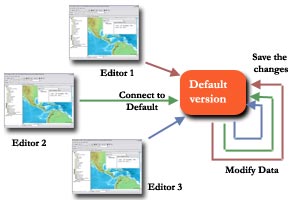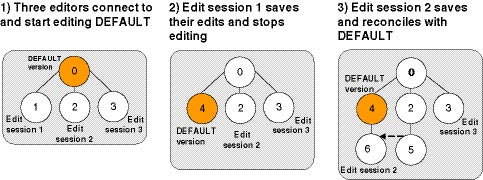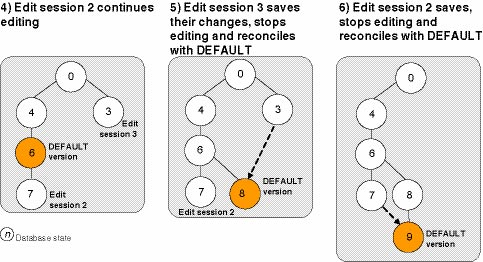|
The simplest approach to supporting multiuser access to a versioned geodatabase is for many editors to directly edit the DEFAULT version.
 As each editor opens the DEFAULT version for editing, a new, unnamed,
temporary version is automatically created; editors do not have to explicitly
create a new version. As each editor opens the DEFAULT version for editing, a new, unnamed,
temporary version is automatically created; editors do not have to explicitly
create a new version.
This temporary version is accessible only to the current editor, and
it automatically evolves through the succession of states created by each
new edit operation. When the editor saves his work or ends the edit
session, this temporary version is automatically reconciled with and posted
to the DEFAULT version.
If another editor has edited DEFAULT since the current editor started
editing, when the other editor saves his changes, he receives notification
that the version has been altered since the edit session began. The second
editor's
changes must be saved again to accept the results of the automatic reconcile
operation that has just taken place. This automatic reconcile notification
may be bypassed if required.
The multiple, concurrent edit sessions on
the DEFAULT version have the following effect on the state tree.
Pros
- Simplicity—This versioning workflow is probably most applicable to
situations in which the units of work are fairly small or persistent
design alternatives are not required.
- If no conflicts are detected, the edits are directly posted to the
DEFAULT version without user intervention.
Cons
- The DEFAULT version is constantly changing and is vulnerable to
inadvertent or malicious modification. Specific action is required on the
part of the database administrator to preserve a historical record of the
changes made to the DEFAULT version.
- This workflow does not support long transactions, which typically span
many edit sessions, or the creation of alternative design versions.
- There are some performance and workflow issues associated with this
approach: if a number of editors save and reconcile their changes to the DEFAULT
version at the same time, other editors may notice a degradation in response
times for their own save requests. The ArcGIS application software
automatically detects changes to the current edit version and will automatically
reconcile and post if the version has been modified by another edit session.
This is required for data and version consistency.
Because version reconcile is a serial process—that is, only one reconcile operation
per geodatabase can be active at any given time—these frequent reconcile and
posts in every edit session can have a negative impact on performance and
response times. Editors may also receive a warning that the target version has
changed since they started their edit sessions; they must save again to accept
the changes made by other editors and may have to wait for any active reconcile
and post operations to complete before they will be able to complete their own.
In a large, multieditor enterprise geodatabase, it is better to avoid situations
where many users reconcile and post to a common parent. Reconcile and post
exclusively locks the parent version. While this lock is in place, other users
will be prevented from completing their tasks.
- As all reconcile operations are undertaken automatically, this approach
does not support batch reconcile/post processes.
|
 As each editor opens the DEFAULT version for editing, a new, unnamed,
temporary version is automatically created; editors do not have to explicitly
create a new version.
As each editor opens the DEFAULT version for editing, a new, unnamed,
temporary version is automatically created; editors do not have to explicitly
create a new version. 
